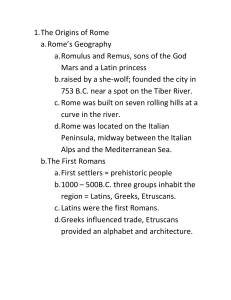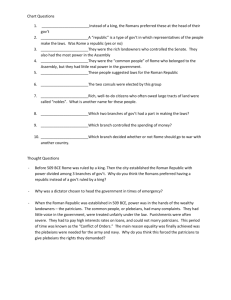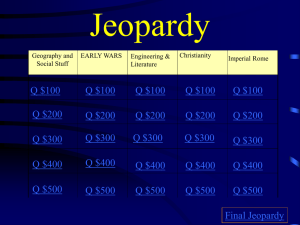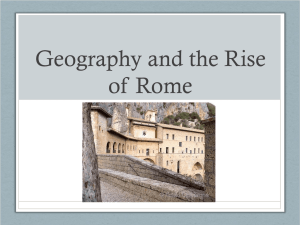Rome Stations Activity
advertisement
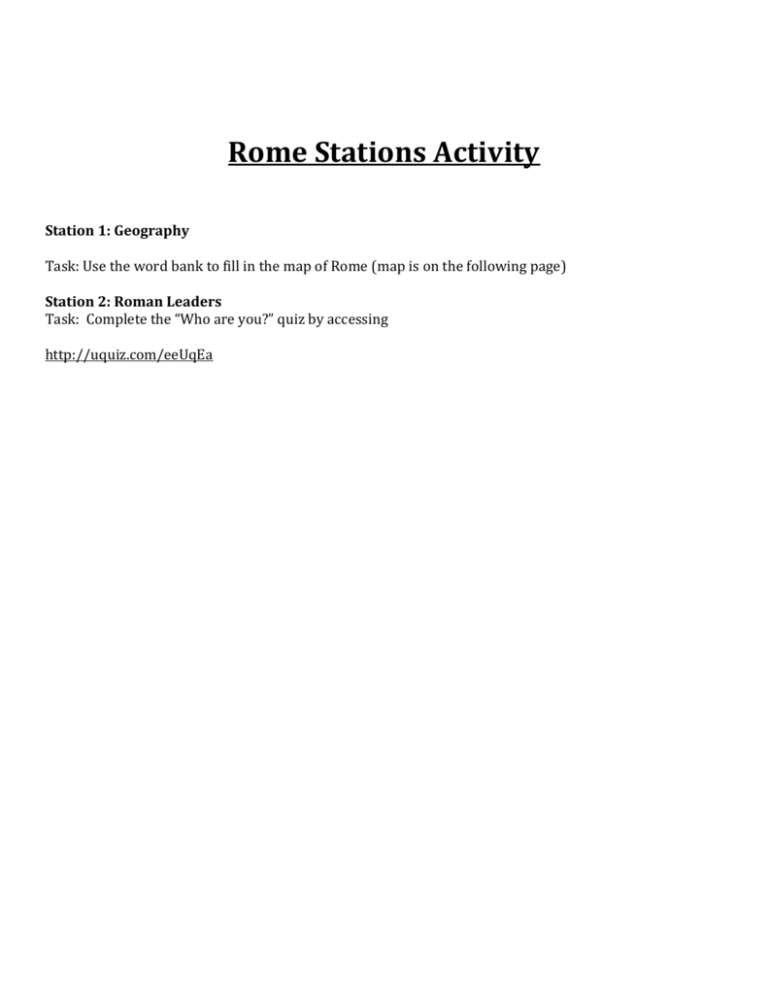
Rome Stations Activity Station 1: Geography Task: Use the word bank to fill in the map of Rome (map is on the following page) Station 2: Roman Leaders Task: Complete the “Who are you?” quiz by accessing http://uquiz.com/eeUqEa Station 3 – Roman Technology – Concrete and Roman Buildings The Colosseum was built of concrete, faced with stone, as were most amphitheaters. The Romans also used concrete (an ancient Roman invention!) to build the dome of the Pantheon, a temple dedicated to all the Roman gods, which even today is still one of the largest single-span domes in the world. How did the Romans make concrete? The Roman writer Vitruvius in his Ten Books of Architecture, gives us the Roman recipe for concrete, which is for every one part chalk add 2 to 3 parts sand. Mix with 15-20% water (Vitruvius, Book 2, chapter 5). Vitruvius goes on to say that concrete used in the construction of buildings and structures exposed to lots of water, such as bath houses, aqueducts, and harbor construction, should be made with a particular kind of volcanic sand, called pouzzolanic sand, because it was harder and more durable. Station 3 – Roman Technology - Roman Roads There is an old expression, "All roads lead to Rome." In ancient Rome, Rome was the heart of the empire. Each time a new city was conquered, a road was built from that city back to Rome. Roads were built in straight lines. Many had gutters. Along the side of road, the Romans built road signs called milestones. Milestones did not give any information about other towns in the area. Milestones told how far it was back to Rome. The Romans built roads so that the army could march from one place to another. They tried to build the roads as straight as possible, so that the army could take the shortest route. How the Road was Built... 1) First, the army builders would clear the ground of rocks and trees. They then dug a trench where the road was to go and filled it with big stones. 2) Next, they put in big stones, pebbles, cement and sand which they packed down to make a firm base., 3) Then they added another layer of cement mixed with broken tiles. 4) On top of that, they then put paving stones to make the surface of the road. These stones were cut so that they fitted together tightly. 5) Kerb stones were put at the sides of the road to hold in the paving stones and to make a channel for the water to run away. Station 3 - Roman Technology – Aqueducts Why did the Romans need aqueducts? As cities grew, the ancient Romans needed more fresh water. To solve this problem, they built aqueducts. These were massive construction projects. An aqueduct, properly speaking, is the entire conduit - from fresh water spring to town. (CONDUIT—A natural or artificial channel through which fluids may be conveyed). How did the water get from the countryside? Where aqueducts had to cross valleys, some were built above ground, on arches. Most of the time, they were underground conduits, and sometimes conduits lying right on the ground. These conduits could be made of clay or wood, covered or encrusted with stone. The pipes inside the conduits, that carried the water, were made of lead, which in turn required vast mining enterprises and then transportation to get all this pipe out into the field all over the empire, although most of the lead was mined in Spain. Why was planning important? What is extraordinary about the aqueducts is the planning that must have gone into their construction. Since the ancient Romans didn't use pumps, aqueducts had to be positioned at a relatively constant gradient for dozens of miles. You try building something that drops by only 100 feet in 40 miles.... and you'll begin to understand why scholars refer to the ancient Romans as such great builders! Station 4 – Life in the City of Rome City Homes - Rome grew from an important city into a huge, crowded, noisy, smoky, dusty city, with beautiful temples and public buildings. The rich had gracious homes, each with an entrance atrium, which was the center of family life. For those who were not quite as rich, there were apartment buildings, some quite nice ones, and there were shabby tenements for the poor. Narrow streets wound between the seven hills. Getting around Rome: Some people walked around Rome. Some were carried in covered litters, with curtained couches carried on poles by slaves. Soldiers strode though town in chain mail or leather armor. Workmen hurried in belted tunics of dark wool. Before daylight, boys hurried to school. Later in the day, Roman citizens strolled around town in white wool tunics. Shops lined the streets. Government Business: Down in the Forum, courts were in session, and the great Senate orators met and argued. Entertainment: Even for the poor, life in the city was lively. There was always something going on, like the many religious festivals with entertainment paid for by the rich, and chariot racing with an open track that ran between the seven hills. Everyone could also attend the theater. These were free spectacles that all the people could enjoy. “Typical” Roman Day The ancient Romans started their day with breakfast. Then, they got dressed to go out. The kids went school. Once they got dressed, the adults might wander down to the Forum to do their shopping and banking. Next stop, the baths! In the afternoon, wealthy Romans took some time to rest at home. The poor worked constantly. When the kids got home from school, they played with their friends, their toys, and their pets. Dinner was different for the rich and the poor. But all Romans could enjoy the spectacles. Admission was free! Station 4 – Daily Life Life in the Roman Countryside Although life was socially much slower paced than it was in the city, it was still Roman. The kids played the same games as kids did in the city. The atrium was the center of the home. The baths were an important part of daily life. There were many rural festivals to enjoy. Rich citizens escaped to their country estates to oversee their farms, but mostly to enjoy some rest from the social duties of the city. In the country, they enjoyed hunting, riding, fishing, and of course, the baths, dinner, and a busy social life between the villas. The average farmer probably worked hard seven days a week, but enjoyed the local town on market day, selling his wares, meeting with friends, catching up with news. His wife looked after the house and family and supervised the slaves. Dining was different than it was in the city. In the city, big meals were enjoyed in the late evening. On the farms, the day ended with an early meal, usually food left over from the large noon meal. Use for questions #1 and 2 Station 5 – The Roman Republic – Government The History of the Twelve Tables NO MORE KING!! After a 16-year battle with their last king, Tarquin the Proud, the people of Rome vowed never to be ruled by a king again. The people wanted to be ruled by elected leaders. They wanted to vote on any laws suggested. They wanted to vote on who would rule over them each year. In 509 BCE, over 2500 years ago, the citizens of Rome created a new government. They called it THE ROMAN REPUBLIC. Who did not have rights? Although many things changed, and much improved, women, children, and slaves were still not citizens of Rome. They had no voice in government. Only adult free Roman men were citizens. How did life improve for many? But, things did improve under the Republic. About 50 years after the Roman Republic was formed, the leaders of the Republic wrote down many of the old laws, to make sure everyone understood them. History refers to this group of laws as "The Twelve Tables" because the written laws were organized into 12 sections. What kind of laws were the Twelve Tables? These laws talked about property, crime, family, theft, marriage and inheritance. These laws were written down. They were engraved on tablets of metal and put on display at the Forum in the city of Rome, so that everyone could see them. Each law applied to every Roman citizen, be he rich or poor. That was a huge change for the better! USE FOR QUESTIONS 3-5 Station 5 – Roman Government – The Roman Republic Consuls: Under the Republic, two (2) elected consuls shared the head of government. Consuls were members of the Senate, who had been elected to serve for a one year term in the position of Consul, the highest position in government under the Republic. The consuls most important power was that they controlled the army. The Senate was composed of leaders from the patricians, the noble and wealthy families of ancient Rome. They were the law makers. They controlled spending. Members of the Senate were not elected. They were chosen by the Consuls. Once chosen, they served for life. There were 300 seats in the Senate. When a seat opened, a new Senator was selected by the current Consuls. The Assembly was composed of all the plebeian citizens of Rome, the common man. The Assembly did not have a building. It was the right of the common man to assemble in the Forum and vote. The Assembly gained power: In the beginning, the Assembly had very limited power. However, the Assembly had one power that was very impressive - it was the Assembly who voted each year on which two members of the Senate would serve as Consuls. As a noble, if you wanted to rise to the level of Consul, the highest position in government under the Republic, you needed to gain the support of the plebeian class. Since it was the Consuls who filled empty seats in the Senate, if the Assembly chose their Consuls well, they could slowly gain power in government by putting people in charge who were sympathetic to their needs. Some members of the Assembly became quite powerful in government in their own right. Some tradesmen were very wealthy. There is an old expression - money talks - which means the rich seem to be heard more easily than the poor. CONVINCING SPEAKERS!! In ancient Rome, certainly money talked, but so did those who had the power of speech. The Romans loved a great orator. When the Assembly met, down at the Forum, many speeches were going on at the same time. One speaker might say, "Rome's roads need repair!" Another speaker might say, "We need to stop crime in the streets." If you wanted your speech to have an impact, it did not matter how rich or poor you were. What mattered was how persuasive you were as a speaker. USE FOR QUESTIONS #3-5 Structure of Government Under the Republic 2 Consuls Head of Government Senate (300 members) Assembly PATRICIANS 1 year term Consuls chose the Senators Ran the government, overseeing the work of other government officials. Directed (commanded) the army PATRICIANS Life term Acted as judges Approved or disapproved laws Voted on laws suggested by made by the Assembly government officials Made decisions concerning Declared war or peace relationships with foreign powers In an emergency, consuls could choose a dictator – a single ruler to make quick decisions. Both consuls had to agree on their decisions. Each had the power to Veto the other. In Latin, veto means “I forbid.” Advised the consuls. Advised the Assembly. PLEBEIANS Elected the 2 Consuls Elected government officials including judges. Directed spending, including tax dollars Use for Question # 6 Here are a few of the laws in the Twelve Tables 1. If you are called to go to court, you must go. If you don’t show up, you can be taken to court by force. 2. If you need a witness to testify and he will not show up, you can go once every three days and shout in front of his house. 3. Should a tree on a neighbor's farm be bend crooked by the wind and lean over your farm, you may take legal action for removal of that tree. 4. If it's your tree, it’s your fruit, even if it falls on another man’s land. 5. A person who had been found guilty of giving false witness shall be hurled down from the Tarpeian Rock. 6. No person shall hold meetings by night in the city. 7. A dead man shall not be buried or burned within the city. 8. Marriages should not take place between plebeians and patricians. (As time went on, this law was changed. When the tables were first written, this was the law.)
